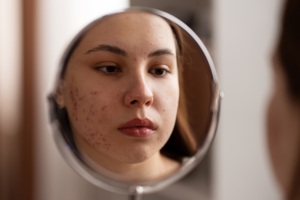Can The Ayurvedic Approach Help in Managing Hyperpigmentation?
A frequent skin issue that affects people with all skin types is hyperpigmentation, which is the darkening of certain skin areas caused by an overabundance of melanin. For many people, hyperpigmentation—whether brought on by inflammation, hormone fluctuations, or sun exposure—can be a source of aggravation. In this blog post, we’ll explore the causes, prevention, and efficient treatment methods for hyperpigmentation, providing you with the knowledge to help you attain a bright and balanced complexion.

Causes of Hyperpigmentation:
- Sun exposure
- Hormone changes (during pregnancy or birth control usage),
- Skin injuries
Inflammation is one of the reasons that can lead to hyperpigmentation. Identifying the underlying reason is essential to creating a successful treatment strategy.
Types of Hyperpigmentation:
- Melasma
- sunspots,
- post-inflammatory hyperpigmentation.
Knowing the particular type will help you choose the best course of action for therapy.
Preventive and defensive measures:-
- Sunscreen as Your Shield:
Avoiding and treating hyperpigmentation requires regular sun protection. Discover the value of sunscreen, how to select the best type, and how to apply it to your regular skincare regimen. - Healthy Lifestyle Options:
Investigate lifestyle elements that can support general skin health and help avoid hyperpigmentation, such as a balanced diet, enough hydration, and stress management.
RISK FACTORS: Numerous variables can affect hyperpigmentation, and it’s important to recognize these risk factors for both therapy and prevention. The following are some significant risk factors for hyperpigmentation:
- Exposure to ultraviolet (UV) rays from the sun for an extended period without protection is one of the main risk factors for hyperpigmentation. UV radiation can increase melanin synthesis, which can result in the formation of dark spots and sun-induced hyperpigmentation.
- Age: Reduced cell turnover, accumulated sun exposure, and shifts in melanin distribution can all contribute to an increased risk of hyperpigmentation in older people’s skin.
- Certain Medications: An increase in pigmentation is a possible adverse effect of certain medications, such as certain antibiotics, antimalarial treatments, and chemotherapy agents.
- Hyperpigmentation, for instance, may result from harsh chemical peels or from using some exfoliating chemicals incorrectly.
- Endocrine Disorders: Conditions that impact the endocrine system, such as Addison’s disease or hormone abnormalities, can disrupt the production of melanin and lead to hyperpigmentation
- Liver Disorders: Hepatitis and liver disease are two conditions that can affect the liver and make it more difficult for the body to metabolize and eliminate toxins, which can result in skin discoloration.
- Genetic Predisposition: An individual’s risk of acquiring pigmentation disorders may be increased by a family history of hyperpigmentation or skin diseases.
- Cosmetic and skincare products: If used improperly, several skincare chemicals or cosmetic procedures can cause skin irritation and pigmentation problems.
- Ethnicity and Skin Type: People with darker skin tones, especially those with higher melanin levels, are typically more prone to hyperpigmentation. People of African, Asian, Hispanic, and Middle Eastern ancestry are included in this.
Hyperpigmentation is a common issue, getting a bright, even complexion is achievable with focused care at Star Ayurveda. You can start along the path to healthier, more beautiful skin by taking preventative steps and investigating efficient remedies. Doctors at Star Ayurveda take the complete history of the patient and prescribe medicines that are prepared naturally and cure the patient without leaving any side effects. For more information about the hyperpigmentation, follow the link: Ayurvedic Treatment for Hyperpigmentation